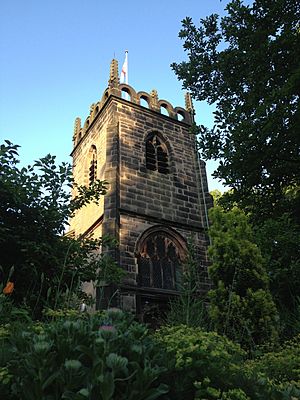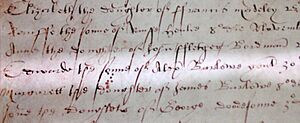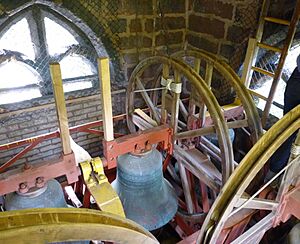Church of St James, Didsbury facts for kids
Quick facts for kids St James, Didsbury, Manchester |
|
|---|---|

St James, Didsbury
|
|
| 53°24′36″N 2°13′54″W / 53.4100°N 2.2318°W | |
| Denomination | Church of England |
| Churchmanship | Open Evangelical |
| History | |
| Dedication | St James |
| Administration | |
| Parish | St James & Emmanuel, Didsbury |
| Deanery | Withington deanery |
| Archdeaconry | Manchester archdeaconry |
| Diocese | Diocese of Manchester |
St James, Didsbury is a historic Church of England church located on Stenner Lane in Didsbury, a suburb of Manchester. It is a very important building, given a Grade II* listing, which means it's a particularly important building of more than special interest. St James and Emmanuel Church together form the parish of St James and Emmanuel, Didsbury.
Contents
The History of St James Church
Early Beginnings: From Chapel to Church
The story of St James Church began a long time ago. In 1235, a man named Albertus de Gresley gave land to Nicholas de Longford. Nicholas was the Lord of the Manor of Withington. He wanted to build his own chapel in Didsbury.
The first time this chapel was mentioned was in old records from Lancashire. It said that 'William, Chaplain of Didsbury, came not on the first day and was fined'. This shows the chapel was already in use.
A Place for Burial and Growth
In 1352, a sad event happened. The Black Death, a terrible sickness, was spreading. The Bishop of Lichfield gave permission for a churchyard to be created. This was so people who died from the Black Death could be buried there.
Later, in 1541, the Diocese of Chester was created. The church was then moved from the Diocese of Lichfield to this new diocese. The area covered by the church was very large. It stretched from the River Mersey all the way to Moss Side. It also went from Chorlton-cum-Hardy to Heaton Norris and Reddish.
Keeping Records and Famous Visitors
In 1561, Queen Elizabeth I ordered that all births, deaths, and marriages must be recorded. The original book with these records is kept safe in the City of Manchester archives.
One special entry in this book is the baptism record of Saint Ambrose Barlow. He was baptized on November 30, 1585.

Recent Leadership Changes
In 2025, the church's team rector, Nicholas Bundock, was chosen to become a bishop. He was installed as the Bishop of Glasgow and Galloway.
Architecture and Design of St James
A Mix of Old and New Styles
St James is an old Anglican church. It started in the medieval times, which means it's very old! But it has been changed and added to a lot over the years. Many changes happened in the 1600s and in the mid-1800s. Because of its special history and design, the church was named a Grade II* listed building on February 25, 1952.
The very first chapel was probably a small prayer room from the 1200s. The church was rebuilt in the early 1600s. This is when the "dumpy" tower was added. A special stone above the tower's north door remembers the people who helped pay for it. These were Sir Edward Mosley and Anne Mosley, and the date 1620 is on the stone. The pointy tops (called pinnacles) and loops on the tower were added in 1801. The Mosley family were important local people who helped the church a lot.
The chapel officially became the parish church of Didsbury in 1850. The main part of the church, called the nave, was built in 1855. The area around the altar, called the chancel, was built in 1871. The east part of the south side aisle was added in 1895. The church is built from red sandstone and has slate roofs.
Inside the Church
A famous expert named Nikolaus Pevsner said the inside of the church was "odd." He meant that it had parts from the early 1600s, but later changes made it look different. The old galleries from the 1700s have been removed. A lot of rebuilding happened in the 1850s and 1890s.
All the beautiful stained glass windows you see are from the 1800s. The church also has impressive monuments for people who have passed away. Many of these are for the Mosley family. There is a very good monument from the early 1600s. It has three sections with columns and shows kneeling figures. This monument remembers Ralph Mosley, who died in 1616.
Another monument shows Sir Nicholas Mosley kneeling. He built Hough End Hall and is shown wearing the special clothes of the Lord Mayor of London from 1599. Ann, Lady Bland, who was a Mosley heiress, is also shown. She started St Ann's Church, Manchester and is buried at St James.
In 2012, the inside of the church was repaired and updated. This was part of the celebrations for the church's 775th anniversary.
The Bell Tower
The bell tower at St James has six bells. These bells were made in Gloucester in 1727. The bells are rung before church services on Sundays. They are also rung for weddings and other special events.
See also
- Grade II* listed buildings in Greater Manchester
- Listed buildings in Manchester-M20


